News
News / 04/30/2020 / 2480
René Millet, a French diplomat who came to serve at the French Embassy in Belgrade on October 12th, 1885, encountered for the first time Serbian wines. His fascination with wines from Serbia, a country he had known little about until his arrival in Belgrade, took him to all wine regions of Serbia, where he had an opportunity to get acquainted on the spot with the current state of local viticulture and winemaking.
As part of preparations for the World Exhibition in Paris in 1900, René Millet was given the task of preparing a detailed guide through Serbian economy and trade, with special reference to winemaking of that time, which would be useful to French wine merchants. Thus, as part of the publication La Serbie Economique et Commerciale, an exhaustive overview of Serbia was published, and the part related to winemaking is especially important to us.
Given the importance of information contained in this document, we bring you the integral text (for the first time translated into English):
______________________________________________________
Serbia is a wine-producing country that can be compared to Hungary and Dalmatia. Although winemaking is still in its infancy there, local wines still have flavors, strength and richness that help increase their sales in foreign trade. The French were not the last to pay more attention to those wines, because it's been years since our wine merchants from Bordeaux and Sète found their way to the vineyards along the Danube. In 1888, difficulties in trade relations with Italy forced these merchants to carefully examine various other parts of Europe in order to find substitutes for Italian wines. While the ships departed Bordeaux towards Rijeka of Senj to load Hungarian wines there, other ships chartered by our compatriots would sail under the French flag along the Danube and dock in small ports where Serbian wine export points were located. The number of export certificates issued by the French Embassy testifies to business activities that deserve great attention.
So, as far as wine is concerned, we are facing already established relations between our compatriots and Serbian wine producers. Therefore, our task will be much easier in some respects, because we will not have to show them new wine trade routes. But little knowledge they have about this region forces them very often to turn to various and very expensive intermediaries. Also, they got in contact with winemaking parts of Serbia only in the regions which are connected to the sea by the Danube river. They never ventured inland, where one can also find wines worthy of notice, which are more diverse than those from the Danube regions.
What's more, one gets even more surprised when, traveling to the least travelled parts of Serbia - for example in the vicinity of Mt. Kopaonik, which separates Southern Serbia from Novi Pazar Sandžak, one notices at a considerable height, huge vineyards that endlessly cover the slopes and mountain foothills and cast lush and thick greenery on the soil burnt by the eastern Sun. There, in all taverns, wine is drunk like water. That wine, which is in some places pale red, light and flavorsome, and elsewhere heavy, thick and full of tannins, could be improved by minor but very crucial interventions and turned into the most excellent wine.
These are real neglected treasure troves, which have long been forgotten in the most remote mountainous areas. So to speak, they were handed over to the good-natured, honest and kind inhabitants of those parts as a legacy whose value is unknown to them. How often do they leave grape bunches to rot on the vine, and how often do they pick the best and worst grapes, both ripe and semi-ripe, which subsequently turn into vinegar! What crazy and dangerous freedom these vines are granted as they spread abandoned, completely overwhelmed by abundant vegetation and its beautiful shoots forced to roll in the mud and dirt!
However, the situation looks different nowadays because now the railway passes through a part of those fertile lands. It can be said that the days are coming when these by nature brave and bright inhabitants will reject that negligence, adopt state-of-the-art techniques of winemaking and respond to the call of foreign trade. With the growing demand fuelled by our national commerce, tireless work and unsurpassed professional expertise, we should be their guides, giving them prospects of a certain and steady profit, which would come as a result of such a philanthropic enterprise. Our merchants will come across certain by-products during their journey that should not be overlooked so easily, i.e. plum brandy (šljivovica) and pomace brandy (komovica), all healthy, natural, undiluted and generally well-reputed throughout the East as a widely common drink.
Various Serbian wine regions
The area covered with vineyards in Serbia totals about 98,326 hectares nowadays, which is very little if you take into account that the total surface of the Kingdom is about 5 million hectares.
There are 6 different types of wine in Serbia. Here are their places of origin: Negotin, Požarevac, Smederevo, Šumadija, Kruševac, Niš.
NEGOTIN WINE, which is the most famous, is obtained from these vineyards: Kobišnica, Mihajlovac, Badnjevo and Bratujevac.
It is necessary for our merchants to get acquainted with the very simple way of vine training in that area, because the quality of wine may depend on them. Therefore, they might be eager to propose certain improvements so as to improve those wines.
The vines are small and densely planted, and very rarely supported by posts. Pruning is quite unskillful because instead of leaving two or three shoots, no more than one is left. They use a small sickle for pruning. Hand saws and scissors are very rarely used. In the winter, vine trunk is covered by soil, which is common in all vineyards in Serbia except in Župa.
Weeding of the vineyard with a hoe is performed two or three times a year, in May and June. The third hoeing, which should be done in August, is rarely performed because ignorant and careless workers often cause damages to the vines. The vines are planted in the same row at a distance of 60 to 80 centimeters. Distance between the rows is 65 to 75 centimeters. Instead of planting trees in the vineyards that give a little shade, such as peaches, they tend to grow numerous walnuts that create deep shade and prevent the grapes from ripening.
The harvest is usually in mid-September, but it is done very unskillfully. Instead of picking ripe sections of the vineyard and wait for the rest to ripen the following day, the harvest is done all in one go. Grapes are thrown into simple open-top containers and there are no special devices for crushing grapes. To do so, the Serbs use an ordinary wooden mallet, which has that disadvantage of not being able to separate berries from stems. Wine press is very rarely used and the grapes are stomped with bare feet.
WINES OF POŽAREVAC and SMEDEREVO are very similar to Negotin wines, but white wines prevail in those regions. Viticultural practice is almost the same. However, vines are allowed to grow taller, supported by posts.
The soil is better cultivated, because its limestone composition makes it softer and lighter. The soil here is much looser and easier to cultivate. The third hoeing involves making a long furrow along the row rather than digging around each vine separately. In addition, the proximity of the Royal Vineyard, which is located in the vicinity, showcases the best practices, so no wonder that local grapes are partly consumed as table grapes.
The harvest is done in October, which is the reason why grapes are usually sold as fruit. After all, berries are quite large and remain firm and intact. At the same time, berries remain undamaged during the autumn rains, which are so harmful to other types of grapes.
WINES OF ŠUMADIJA, KRUŠEVAC and NIŠ are predominantly red, but not as dark as Negotin wines.
The method of cultivation is almost the same as in Negotin. The vines are smaller, therefore not supported with posts. Since the local climate is much more temperate, vine trunks are never covered by soil in the winter. But, owing to heavier soils and lush grass, weeding with a hoe is required three times a year.
Harvest is done even more carelessly than elsewhere. There is no selection of bunches, everything is picked and mixed together, ripe grapes as well as unripe and rotten ones. The barrels in which the grapes are crushed are in a very bad condition - they are neither washed nor cleaned, as a result of which the wine gets an unpleasant taste and cannot be kept for a long time.
All the above said shows how much education is needed and what can be done when it comes to cultivation of vineyards and winemaking in Serbia. Why are our wine merchants from Béziers, Narbonne, Sète and Bordeaux, who use Serbian wines so much for blending, so indifferent to providing such education?
If, for example, a French wine expert settled in Serbia and became the owner of several vineyards, he could also buy wines from other producers and eventually handle them in a way that would be most adequate to withstand export. He could also give advice to his partners regarding cultivation of their vineyards. For example, he would discourage them from planting young vines on recently cleared land. He would advise them to plant vines in a straight line and at the equal distance from each other, rather than planting them without any order, as can be seen especially in the southern parts of the Kingdom. Also, he would advise them to harvest grapes at a convenient time; to separate berries from stems; to use only clean vessels, to be careful when racking wine, etc.
Exportable wines
According to official customs statistics, let us present this comparative list of Serbian wine exports starting from the year 1881.
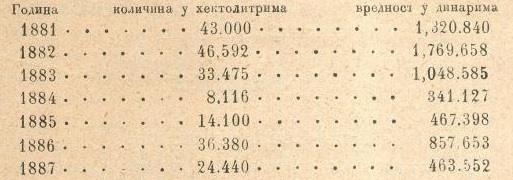
Until 1886, it was impossible to trace this export, because various customs authorities that kept records of wine shipments never registered the destination country. Since 1886, very strict orders have been issued, so for the following three years we know exactly which French wine houses have been purchasing Serbian wines. For example, in 1886, France accounted for more than 607,000 dinars worth quantity of 27,346 hectoliters, out of Serbia's total export value of wine amounting to 857,653 dinars. Switzerland accounted for the rest, but we can freely say that even a portion of it ended up in France.
In the year 1887, in the total export value of 463,552 dinars, export to France accounted for 298,880 dinars, that is 15,311 hectoliters, whilst Switzerland accounted for 305,692 dinars.
However, the requirement in 1888 to provide certificate of origin for Serbian exports gave us an insight into the actual situation. Thus, in the course of that year, the embassy issued 21 certificates of origin, stating that only 4,727 barrels containing 38,000 hectoliters were exported. Therefore, twice more than in 1887 was exported to France. Exported wines mostly originated from Negotin.
As it can be seen from the previous list, the export of Serbian wines fluctuates significantly from year to year. This could be attributed to two causes, firstly, a larger or smaller volume of harvest and a greater or lesser demand from foreign buyers, especially the French. However, substantial increase of orders did not entail a proportional increase in the prices of Serbian wines, as will be seen further below.
We will now examine the quality and prices of wine in Serbia, according to wine regions.
So far, the most famous Serbian wines in France are exclusively Negotin wines.
Particularly the merchants from Bordeaux have long appreciated extraordinary properties of this wine, and even today it is rightly valued because of results it gives when used for blending with other wines.
This wine is dark red and that is why it is called "black", so it is widely known under that name. It contains a lot of tannins, sugar and alcohol, which makes it suitable for export and blending. In general, it does not lose any of its properties during transport. Here is the latest official analysis which reveals properties of wine from four different sub-regions of Negotin.
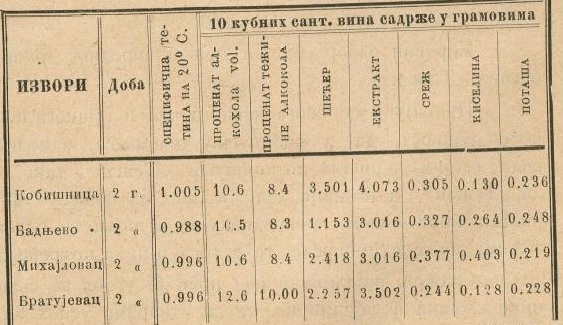
Production of Negotin wine reaches 30,000 to 40,000 hectoliters of red and 15,000 to 20,000 hectoliters of white wines per year, from vineyards covering at least 10,000 hectares in the region. Unfortunately, phylloxera has also arrived here since 1876.
So far, red wines have been predominantly exported, whilst white wines are usually consumed on the domestic market.
According to the latest official rates, prices of red wine purchased from producers on the Negotin square amount to 20.50 dinars per hectolitre on average.
The price of white wine at the same market is 18.50 per hectolitre.
Wines are sold usually in barrels, either for cash or in exchange for goods of the same value, and they are purchased by wholesale traders who live either in Negotin or in the surrounding area. They store wines in cellars and wait for large orders from abroad, especially from France. And so, they sell these wines to foreign merchants with 20 to 25% margin.
It happens that large French wine merchants also send their representative to the market place in Negotin. Then, he typically purchases wine and pays in cash directly to the producers, using a Serbian agent who also comes in handy as an interpreter. The agent is rewarded for his commitment and paid a fee amounting to 2% of the total value of purchased wine, which is a rather small reward. In that case, agents tend to add to each barrel a certain quantity of alcohol brought from France for that purpose prior to shipping. Added alcohol has the task of making transport of young wine easier over rather long distances.
Other merchants avoid those rather hefty costs incurred by sending a special representative, so they use services of some agent who is permanently residing in Serbia. In that case, wine merchants need to deposit a certain amount of cash in some bank or financial institution in Serbia and grant a certain credit to their local agent since the wine has to be paid to producers in cash.
The latter method is less profitable than the former, because we believe that French merchants would always do better to send a trusted person on the spot. No doubt, more attention would be paid to handling procedures, better choice of wine and more orderly dispatching, thus ultimately resulting in full compensation for incurred expenses.
As we all know it, trade relations between France and Negotin have existed for many years, so there is no chance that the newly built Thessaloniki railway will change the transport route of wines originating from these parts of Serbia. Negotin has an exit to Radujevac port, which lies on the Danube below Djerdap, so during high waters, quite large ships can often be seen in that port. In May 1888, two steamboats, each with capacity of 600 tons, arrived in Radujevac. The first steamboat called "Unitas" was a Norwegian steamer rented by a French merchant house. Leaving her port of departure, the steamer was carrying empty sacks loaded in England and empty barrels loaded in Nantes. The voyage from Nantes to Radujevac lasted 25 days, including 3 days of rest for the supply of coal. After the empty barrels were filled with Serbian wine, the ship was said to have returned to Norway, chartered again by a French merchant company. The charter fee was 8.75 dinars for the transport of 1 ton of wine.
That ship, which crossed the same route in 1887, did not have to pay any additional taxes at the exit from Sulina, at the Danube delta. But, in 1888, the administration of the European Danube Commission demanded an export tax of 1.25 dinars per ton, as a result of which a letter of protest was sent to the Serbian government.
Another ship named "Liberté" arrived from France and carried her cargo to France.
Other wine regions are, so to speak, unknown abroad because there are no connections that would facilitate export of wine. As these regions are now intersected by the main line of Serbian railways, these commodities will find their export point at the port of Thessaloniki.
Sailing along the right bank of the Danube, above Djerdap, and not far from Smederevo-Velika Plana railway line which connects the Danube banks with the main railway route Belgrade-Thessaloniki, we first come across the vineyards of Požarevac. In that region, very light red and white wine is produced; the latter is consumed on the spot similar to white wines of Negotin. Concerning red wine, which has been exported exclusively to Austria-Hungarian Empire so far, it is less dark, lighter but richer in alcohol, and it contains more sugar than wines of Negotin. Here is the official analysis:
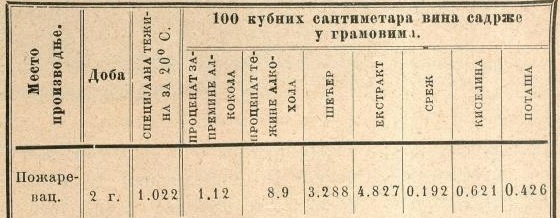
The relevant total surface planted with vineyards totalled up to 8,000 hectares a few years ago, but one-fifth has been destroyed by phylloxera so far. The value of total wine production in the region is up to 25,000 hectoliters per year.
In 1888, red wine from that region was sold at Požarevac market place for an average price of 20 dinars per hectolitre, and white wine was sold for 12.50 dinars per hectoliter.
Similar to Negotin, there are several wine merchants in Požarevac who buy red wines from producers and then export to Austria. However, these merchants by no means have the same importance like wine merchants in Negotin. Very often, Austrian wine dealers go on the spot to buy wine directly from producers. These wines are subsequently used for blending with wines from Karlovci-Srem.
French trade should benefit from wine exports there via Thessaloniki railway.
Continuing along the right bank of the Danube, we reach vineyards of Smederevo, whose wines are exported from the town's port. The wines of that region can also be exported via Smederevo-Velika Plana railway, which connects to the large Belgrade-Thessaloniki railway.
In these vineyards, only white, very fragrant, golden-yellow wines with a lot of alcohol and a little sugar are produced; they have a very pleasant taste, but they have not been the subject of more serious export trade, at least not for long distances because they are very sensitive.
The estimated surface of Smederevo vineyards is 8,000 to 10,000 hectares, which yield close to 20,000 hectoliters of wine per year. However, phylloxera has devastated this area to the greatest extent. At least a quarter of the above mentioned vineyards are destroyed, and locals there report that phylloxera first appeared there in Serbia. It has been introduced on imported vines.
In that region, the King has a beautiful and large vineyard that is beautifully maintained, following the example of our Bordeaux vineyards. But, unfortunately, despite all precautions, phylloxera did not spare it either. More than half of this wonderful estate has been destroyed.
In 1888, the official rates of Smederevo market place indicate average price of 15 dinars per hectolitre.
Continuing further north upstream, right between Smederevo and Belgrade, we discover vineyards of Ritopek and Grocka, which are located on the extension of the mentioned hills. Therefore, those wines can choose between two export points.
These wines are dark red. They are so similar to Negotin wines, that these two are often confused. They have the same properties as Negotin wines, with the difference that they are a bit lighter, and that they are very fragrant. Here is their analysis:
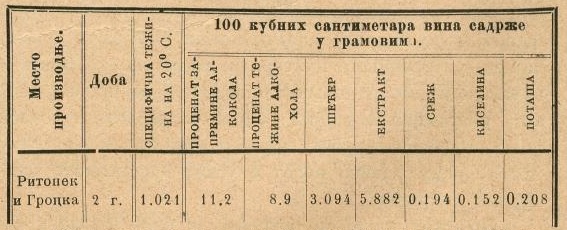
The area covered with vineyards is estimated at 4,000 to 5,000 hectares, which yield up to 15,000 hectoliters per year. In 1888, the average price of these wines was 17.50 dinars per hectolitre.
These wines are mostly purchased by Mr. Golubović, who is also the owner of large vineyards. However, he cannot purchase the entire harvest, so smaller producers sell their wine on the market place either in Belgrade or in Smederevo.
So far, wines from Smederevo and Ritopek have been excluded from large-scale foreign trade, due to transport limitations, but it seems that the connection with Thessaloniki promises to put them in the rightful position.
In the vicinity of Belgrade, there are other vineyards as well as in other regions, e.g. in Šabac and Valjevo. But due to poor cultivation, in spite of extraordinary soil quality, these wines are consumed locally; it seems that at least for the time being, they cannot be exported.
We do not intend to stop there: we will immediately switch to wines that are located in the central parts of the kingdom, i.e. near Belgrade-Thessaloniki railway. In other words, Šumadija wines. The term refers to wines originating from the former province of that name, whose capital city is Kragujevac.
The main locations with these wines are: Topola, Banjani, Orašje, Venčani, Stragari.
As these various wines are very similar to each other, we will examine one of these which is more famous in Serbia. Due to lack of transport options, wine from Stragari is little known in Europe, although it is red, very beautiful in color, and full-bodied, rich in tannins, sugar and alcohol. Until now, that wine has been mostly consumed on the domestic market, particularly in the province of Kragujevac. Nowadays, thanks to more favorable circumstances created by the construction of railway line between Lapovo and Kragujevac, which links this town with the main railway artery, there is hope for bright future of this wine.
Here is an analysis of Stragari wines:
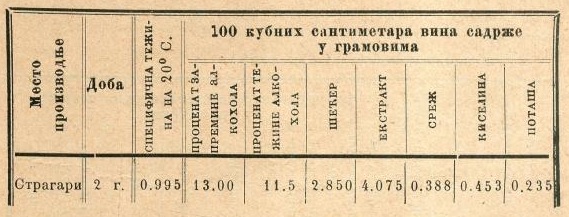
The surface of Šumadija vineyards can be estimated at 12,000 to 14,000 hectares with an annual production of 30,000 to 40,000 hectoliters. There is almost no trace of phylloxera in this area. In 1888, the average price at Kragujevac market place did not exceed the amount of 16.15 dinars per hectolitre.
Heading south, we discover Kruševac wines that are better known as "Župa wines". The main source of Kruševac wines are the following locations: Trstenik, Jasika, Stalać, Vrbnica, Drenča, Brčevo, Botunja, Trebetin, Mramoš.
Wines from these various places can be described in a general manner: these wines are quite red, astringent, with high alcohol content and a lot of tannins. It can be said that these Serbian wines are similar to Niš wines, which feature the highest level of tannins. They have not been exported yet and they are little known in Europe, but due to proximity of Stalać, there is hope that they will soon leave their hiding places. Here is an analysis of some of these wines:
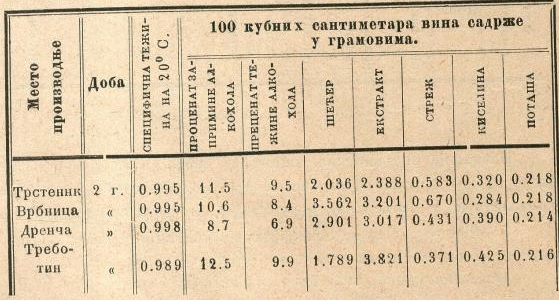
The total surface of Župa vineyards is estimated at 700 to 800 hectares and the annual production is up to 16,000 hectares. There is no phylloxera in that region. According to the official Serbian market rates from 1888, those wines were sold at Kruševac market place for 20 dinars per hectoliter. However, it is worth mentioning that this price, which is extraordinarily high, comes from the fact that the harvest 1887 was very poor. In normal circumstances, the average price of these wines does not exceed 16 to 17 dinars per hectolitre.
Continuously heading south along the railway line, we reach the crossroads in Niš. One branch of the railway line is heading to Thessaloniki and passes through Vranje, whilst the other crosses Bulgaria and meets the Constantinople railway. All wines located on this southern side of Serbia, centered around Niš, can be included in the general term "Niš wines". These vineyards produce both red and white wine. Red wine has a very nice color, high sugar and tannin content, but low alcohol level. It is known for its particularly pleasant smell. Here is the analysis:
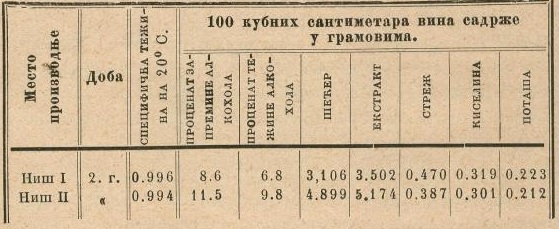
At Niš market place, wine was sold for 16.75 dinars per hectolitre.
White wine has a very pleasant aroma and taste and a nice pale yellow color; contains little tannin and alcohol, but a lot of sugar, so it is very suitable for blending. Here is the official analysis:
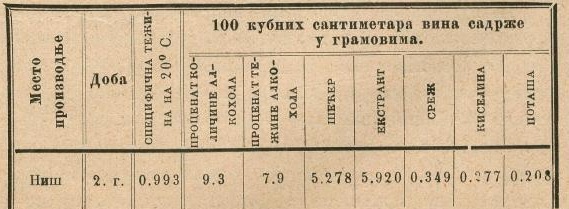
The price of this wine at Niš market place was, according to official data from 1888, 15.50 dinars per hectoliter.
The total surface of vineyards in southern Serbia is up to 30,000 hectoliters, of which one half is white and the other red wine. Phylloxera has not yet arrived in this area. Until now, these wines were usually consumed on the domestic market. They are purchased from small producers or from Mr. Tutunović in Niš, who is also the owner of vast vineyards. This merchant generally buys wine from smaller producers and sells it with a certain margin (20%) to merchants located inland.
Our intention so far was to talk only about the principal Serbian wines and to show them to the French trade. Our traders know only Negotin wines, which are rightly priced. We didn't mention other vineyards that are located in various parts of the Kingdom and which represent the surface of 14,000 hectares, which complement the above-mentioned 80,000 hectares. The weaknesses of these wines prevent their export.
French trade should assess: whether it would be useful to use the new access to the Aegean Sea in order to benefit from these various wines, which would give a very good result had they been exported. Only transport obstacles prevented more massive development of such export attempts. The Thessaloniki railway will be useful only when the tariff gets significantly lowered. For the time being, the tariffs make any transport almost impossible.
Regardless of the previous general explanations grouped by the type of wine, we found it useful to describe wine production of southern Serbia, that is, those districts which Serbia had acquired after the Berlin Treaty and which, although recently liberated and very primitive, both economically and commercially, could one day become the center of the economic activity on the Balkan Peninsula. After all, we have pointed out the importance of Niš, where the railways to Constantinople and Thessaloniki intersect.
The data related to this interesting region mostly concern export products. The data were collected by our vice consul in Niš, Mr. Lacarde. As the annexed districts fall under Belgrade governance in terms of import trade, our representative did not have to follow the development of those industries whose center is elsewhere. On the other hand, his notes on agriculture that he made in his surrounding are vital considering the future of the country.
Therefore, we intended to present integral notes, as Mr. Lacarde compiled them, although we knew that it would be repetition of what we had already mentioned about the whole of Serbia, only with the fact that the information received on the spot confirmed and complemented our general views. In addition, our merchants who would do their business in Thessaloniki and who would be in direct contact with southern Serbia, will no doubt be happy when they find all the data related to this area grouped together.
After the regions of Kragujevac and Smederevo, the regions of Niš and Pirot follow next in the ranking of winemaking regions. They produce white and red wines of ordinary quality, which could be improved. Their price varies between 9 and 12 dinars per hectolitre.
The vineyard cultivation method is quite deviated, similar to other agricultural products. The ridiculous method of mixing fruit of different quality as well as incompetent planting of new vines should be abandoned. Hoeing, and especially pruning - two practices of utmost importance are not performed as they should be. Weeding is non-existent practice. Pickers throw unripe, ripe and rotten grapes in the grape crusher and never separate berries from stems, which is sometimes so necessary. There is no post-harvest care for vines. Cellars are very rarely ventilated, barrels are kept in a careless manner, which explains the tendency of wines from this region to turn into vinegar and why they are short-lived.
The area surrounding Niš and Pirot is full of hills and slopes that are very suitable for vineyard growing because phylloxera has not yet arrived there. Therefore, it is really unfortunate that vinegrowers worthy of that name are so scarce there.
Improvements are made impossible due to widely-present fragmentation of property and due to almost complete lack of funding. In Niš, as well as in Pirot, there is not a single vineyard of significant surface.
The only export until now consists of several hectoliters sent to Hamburg, Szczecin and Thessaloniki, through private channels, as a trial.
The production in these two regions of Niš and Pirot amounts to 670,000 hectoliters of white and red wine, of which 350,000 hectoliters are consumed locally. This shows a surplus of 220,000 hectoliters of wine available for export trade. which is currently distributed in those parts of Serbia where there are no vineyards. Neither other foreign countries nor France have so far had a share in trade of wines from these regions.
The only attempt to export wine to our country was made in 1887, when a wine company from Bordeaux purchased 600 hectoliters of red wine. Due to some misunderstanding and certain difficulties that arose during transport, the agreed deal between Bordeaux merchant and Mr Tutunović was cancelled.
The list below, compiled on the basis of the latest statistics, as well as data collected on the spot, shows the amount of red and white wines in hectoliters available in the regions of Pirot and Niš, from which French trade could benefit.
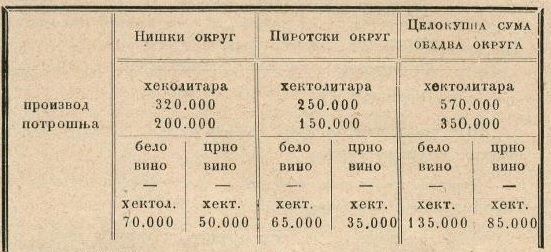
Out of 220,000 hectoliters that constitute wine surplus, almost one third i.e. 85,000 hectoliters, are red wines. Only these would be suitable for French trade.
Are these wines consumable? - I hold that they are, in spite of their flaws which could be fixed or eliminated by better cultivation and greater care in the cellar. However, since these wines are not rich in color, it is worth choosing darker wines. For the time being, it is not possible to determine exactly whether the wines of this region are suitable for blending and whether they can withstand long-distance transport. The experience will tell.
A representative of French wine houses who would permanently settle in Serbia and get assistance from some relevant authorities, could hopefully succeed in changing habits of Serbian winemakers and introduce better practice of making and storing wine.
Winemakers would undoubtedly benefits if they followed the advice aimed at improving sale of their wine.
It is generally held that light wines from Niš region could find export market in Bulgaria, and there is hope that one day the borders of this country will open to them so they can supply Sofia and its surroundings where vineyards are less present.
As it can be seen, Mr. Lacarde's views on Serbian winemaking are quite favorable.
Since Serbia is a wine producing country itself, quite few foreign wines are imported. Thus, in 1886, a total of 400,000 dinars worth of wine was imported. All this quantity was wine from Austria-Hungary, with exception of 5,000 dinars worth of wines imported from France, i.e. from Bordeaux, Burgundy and Champagne. No wonder that Hungary, due to its proximity, supplies some wine to Serbia. These are usually cheap wines, much lighter than the ones produced in Serbia.
(1889)
________________________________________________

Tomislav Ivanović
Awarded wine writer, wine critic and contributor to selected wine magazines. WSET3-certified author and editor-in-chief of www.vinopedia.rs. Member of Vojvodina Sommelier Association. Juror in national and international wine competitions. Lecturing about wines of Serbia and the Balkans. Local partner of Wine Mosaic organization. Co-founder of International Prokupac Day.

Pročitajte i druge članke iz ove rubrike:
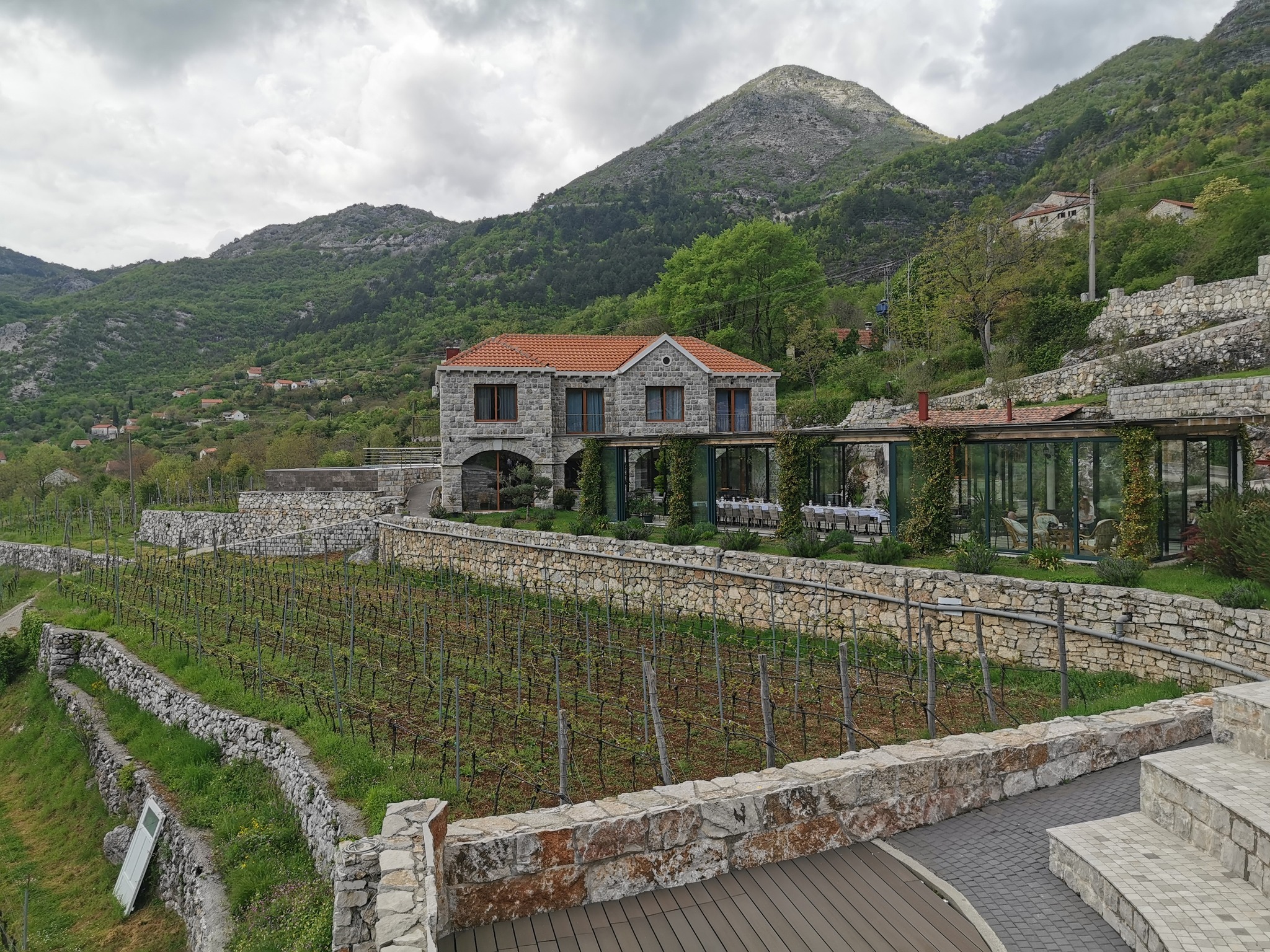

KRATOŠIJA PROBUDILA CRNOGORSKE VINARE
PROČITAJ VIŠE
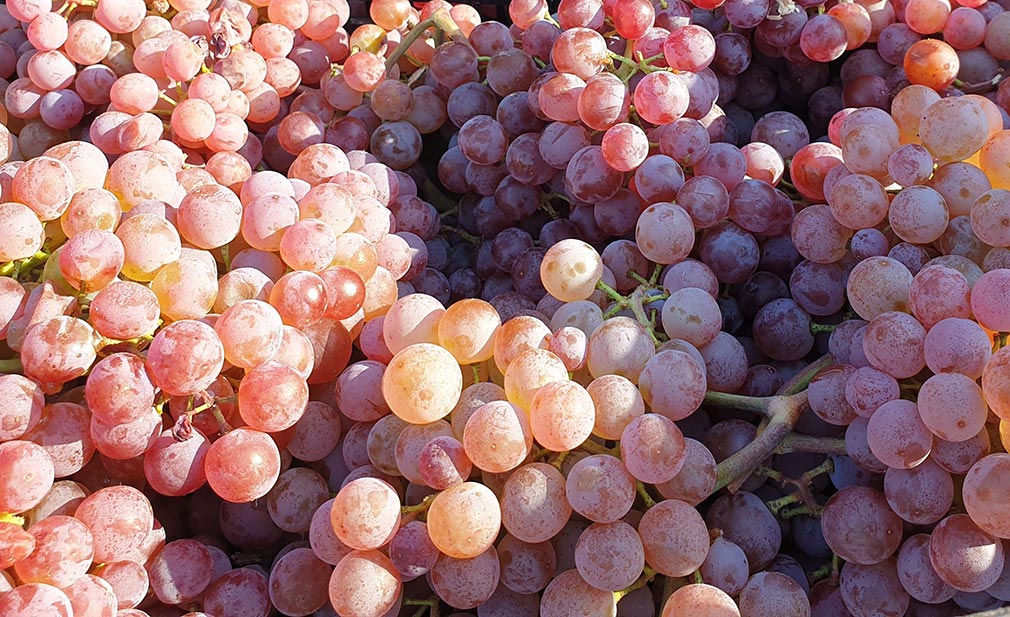

VINOPEDIA TOP 10 2024
PROČITAJ VIŠE
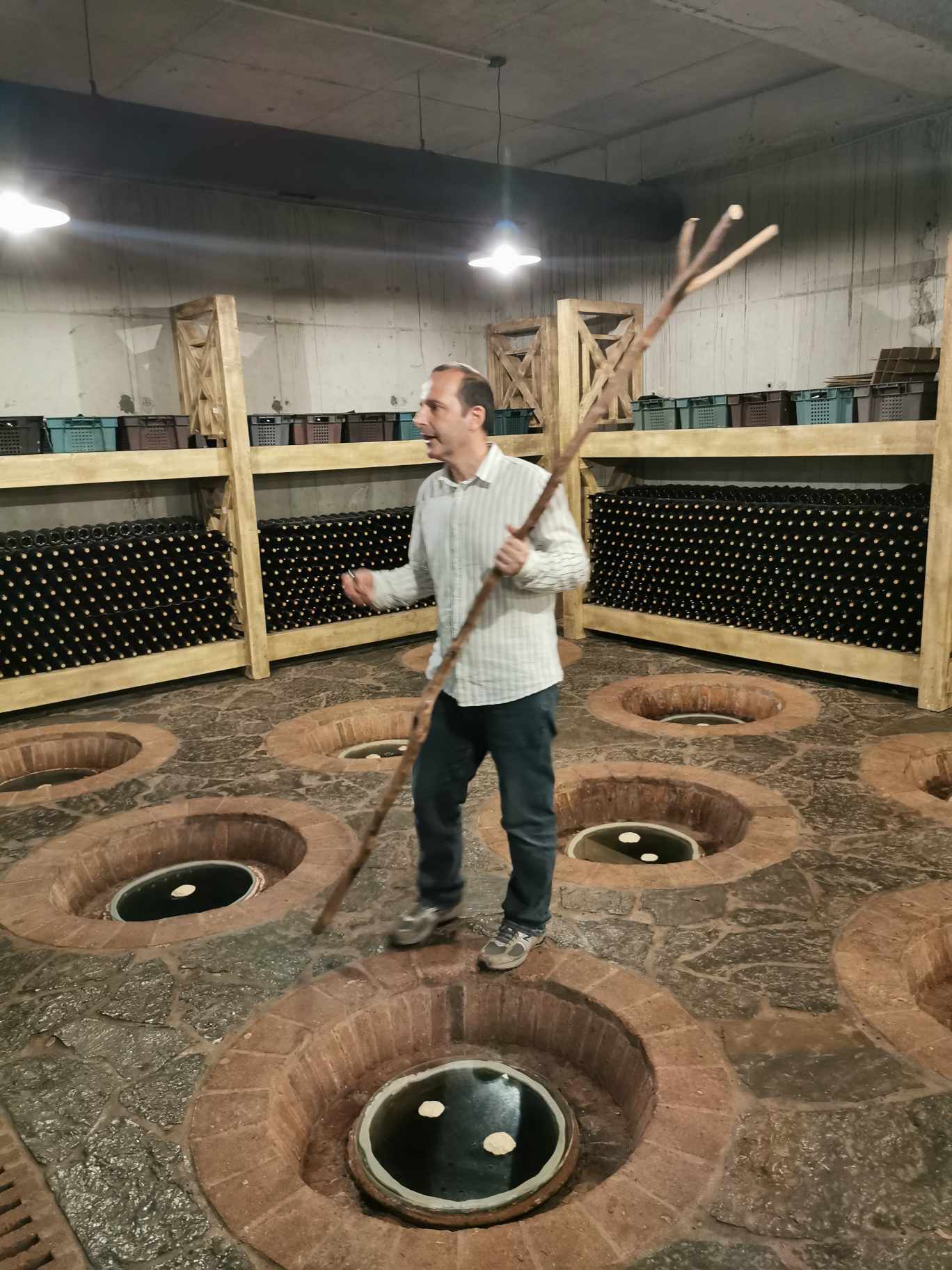

GIUAANI - VINSKI TURIZAM NA GRUZIJSKI NAČIN
PROČITAJ VIŠE


SPASIMO STARE VINOGRADE SRBIJE
PROČITAJ VIŠE
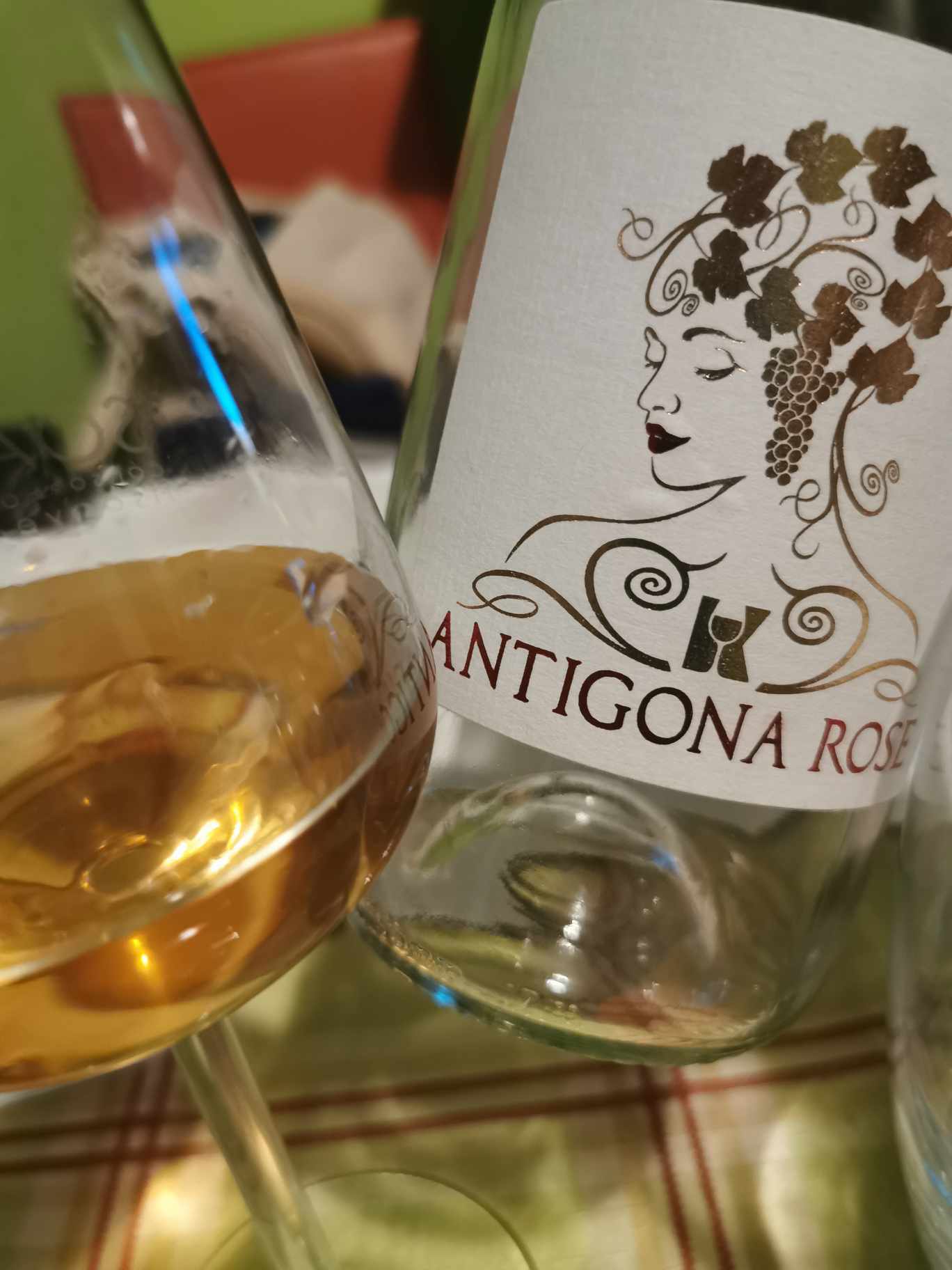

NAŠLI SMO ANTIGONU IZ ORAHOVCA
PROČITAJ VIŠE
Winner MILLESIMA BLOG AWARD 2016

Pobednik MILLESIMA BLOG AWARD 2016
VINO & FINO wine personality of the year 2016

VINO & FINO vinska ličnost godine 2016